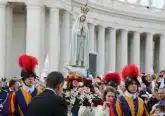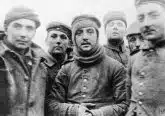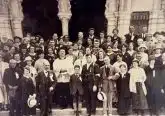Everything you need to know about Fatima (Part 1)
by Mary Farrow
Fatima, Portugal, May 13, 2021 / 07:01 am America/Denver (CNA).
It’s the most popular and well-known Marian apparition in the recent history of the Church.
One hundred years ago, the Blessed Virgin Mary appeared to three shepherd children in a field in Fatima, Portugal. She brought with her requests for the recitation of the rosary, for sacrifices on behalf of sinners, and a secret regarding the fate of the world.
Every local bishop since has approved the apparitions and deemed them worthy of belief, the highest recognition a Marian apparition can receive from the Church.
Miracle researcher Michael O’Neill told CNA that the Fatima apparitions could be considered the “gold standard of Marian apparitions.”
“It has everything you’ve ever wanted to look for in a Marian apparition. It’s got these secrets, the prophecies… you also have a feast day in the general Roman calendar, the approval of the local bishop, and of every pope afterwards, you have the canonization of the visionaries and the basilica that was built, so all the hallmarks of a Marian apparition are there,” he said. O’Neill records the details of Fatima, other Marian apparitions and all things miraculous on his site, miraclehunter.com.
This year, Pope Francis visited the apparition site on May 12-13, the 100th anniversary of the first Fatima apparition. The visit included the canonizations of two of the child visionaries, who died just a few years after the visions.
But even though it’s been 100 years, “the messages of Fatima are as relevant today as they were in 1917,” O’Neill said.
“The essence of the message is a call to conversion, and that’s something that’s as important in our life in modern times as it was when Mary appeared in 1917. I think this 100 year anniversary is a great opportunity for us to revisit the devotion and to re-incorporate it into our lives today.”
Historical context
In 1917, the country of Portugal, like most of the rest of the world, was at war.
As World War I raged throughout Europe, Portugal found itself unable to maintain its initial neutrality and joined forces with the Allies, in order to protect colonies in Africa and to defend their trade with Britain. About 220,000 Portuguese civilians died during the war; thousands due to food shortages, thousands more from the Spanish flu.
Besides the hardships of war, Catholics in the country were also facing a strong wave of anti-clericalism.
Begun in the 18th century during the term of statesman Marquês de Pombal, anti-Catholicism reared its head again after the establishment of the Portuguese First Republic in 1910.
Catholic churches and schools were seized by the government, and the wearing of clerics in public, the ringing of church bells, and the celebrating of popular religious festivals were banned. Between 1911-1916, nearly 2,000 priests, monks and nuns were killed by anti-Christian groups.
This was the Portugal the Blessed Virgin Mary entered into when she appeared to three shepherd children in Fatima in 1917, delivering messages about war, peace, suffering, and conversion.
An angel announces Mary’s coming
In the summer of 1916, Lucia dos Santos, the youngest of a family of seven children, began shepherding her family’s flock along with three of her friends, Teresa Matias and her sister Maria Rosa, and Maria Justino. During this time, an angelic figure appeared before the girls three different times as they were praying the rosary in the fields, but did not speak to them. Lucia’s mother dismissed the incident as “childish nonsense.”
Some time later, Lucia was shepherding with her two cousins, Francisco and Jacinta Marto. One day, eager to play, the children sped through their lunchtime rosary by saying only the titles of the prayers on each bead.
Shortly after they began to play a game, an angelic figure appeared, this time speaking to the children. Over three different appearances, he asked the children to pray and sacrifice. He told them he was the “Guardian Angel of Portugal,” and informed them that Jesus and Mary had “plans of mercy” for them. On the last visit, he gave the children Holy Communion.
“That is pretty unique,” O’Neill said. “There have been thousands of accounts of angels appearing on their own; it’s a rare thing when they come to trumpet the coming of Mary.”
The first appearance of Mary
The next year, on May 5, 1917, Pope Benedict XV wrote a pastoral letter to the world, asking the faithful to petition Mary to bring an end to the war, “that her most tender and benign solicitude may be moved and the peace we ask for be obtained for our agitated world.”
Eight days later, Mary appeared for the first time, on May 13, to three shepherd children – Lucia, 10 years old, and her two cousins, Francisco and Jacinta Marto, 9 and 7 years old, respectively.
She appeared as “a lady dressed all in white, more brilliant than the sun” on top of a small tree in an open field called the Cova de Iria (The Cove of Irene) in the countryside of the small but faithful town of Fatima, and she asked that the children come back to that same spot on the 13th day of the next month.
While she did not reveal her full name right away, the lady did tell the children: “I am of Heaven.” When asked, she promised that all three of the children would go to heaven, though Francisco would have to say “many rosaries” in order to get there.
Aside from the three children, no one was present during the first apparition; but as word spread, the crowds would grow.
The second apparition: the children’s fate
For the second apparition on June 13, dozens of onlookers testified that they were able to see a cloud above the tree where the children saw Mary. This time, she showed the children her Immaculate Heart, pierced with thorns representing the sins of mankind.
Lucia asked Mary for the healing of a sick person, which Mary said would be granted with his conversion. Lucia again asked Mary to take the children to heaven, and while Mary promised to take Jacinta and Francisco soon, she told Lucia that she must stay on earth “some time longer.”
“Jesus wishes to make use of you to make me known and loved,” Mary told her. “He wants to establish in the world devotion to my Immaculate Heart. I promise salvation to those who embrace it, and those souls will be loved by God like flowers placed by me to adorn His throne.”
The children kept the revelation of the image of the Immaculate Heart secret for some time, until Lucia became a nun. Mary again asked the children to return on the 13th day of the next month.
The third apparition: The Great Secret is given
On July 13, Mary revealed what has been come to be known as the “Great Secret” of Fatima, a secret that Lucia divided into three parts and slowly revealed to the public over time. Two parts of the secret were revealed in 1941, when Lucia was asked to record her memoirs by the local bishop. The rest was not revealed until the year 2000, per Mary’s instructions, initially, and then later instructions of the Holy See.
Mary also told the children to continue praying the rosary daily, and to come back to the same spot on the same day of the next month. When Lucia asked the lady to reveal her identity, she again promised the children that she would reveal herself fully in October, and perform a miracle on that day “for all to see and believe.”
She also asked the children to help sinners: “Sacrifice yourself for sinners, and say many times, especially whenever you make some sacrifice: O my Jesus, it is for love of Thee, for the conversion of sinners, and in reparation for the sins committed against the Immaculate Heart of Mary.”
The growing crowds who came with the children to see the apparition witnessed several things during this apparition. Many were able to hear a faint, indescribable sound, believed to be Mary’s voice. Witnesses also recounted a change in atmosphere – when the Lady appeared the sky darkened, and the humid, hot summer air of Portugal suddenly became cool and pleasant.
The crowd also heard a large clap of thunder that shook the ground at the time of Mary’s departure.
The fourth apparition: the kidnapping
With anti-Catholic sentiment still prevalent in the country, the mayor in the district of Fatima had grown suspicious of the growingly popular apparitions, and had unsuccessfully tried to get the children to renounce their story.
Wanting to stop the children from seeing the fourth apparition, Artur Santos, an apostate Catholic and high Mason who was the local mayor, offered the children and their parents a ride in his car to the Cova on August 13. However, he devised a ruse to abandon the parents and to take the children alone to the district headquarters in Vila Nova de Ourem, about 9 miles away. Despite bribes, threats of death by burning oil, and threatening to lock them in a cell with criminals, the children never recanted their story.
Frustrated, and fearing retaliation from the faithful who had grown to love the apparitions, the mayor had the children taken back to Fatima after two days, much to the relief of their parents.
Mary then appeared briefly to the children privately a few days later, repeating her request to pray the rosary daily for the reparation of sins, and asking them to come back on the 13th of the next month.
The fifth apparition: a pillar of clouds and a shower of flowers
Rather than discourage onlookers, the kidnapping incident in August led to an even greater crowd for the September apparition. This time, the visible signs of Mary’s presence became even more pronounced to the crowd. Several witnesses said they were able to see a globe of light, and then a pillar of cloud about 16 feet high by the tree where Mary always appeared.
Many onlookers also described a shower of small white objects – thought to be snowflakes or rose petals – that fell from the sky but disappeared before they touched the ground.
Mary again repeated her promise to the children that she would come again next month and tell the children who she was and what she wanted, and that she would perform a miracle “so that all may see and believe.”
The final apparition: the Miracle of the Sun
On October 13, 1917, the crowds of witnesses had grown to 70,000 – faithful and skeptics alike gathered for what would be the last Marian apparition to the children in the Cova, eager to see the sign from heaven that Mary had promised.
The crowds started to gather at 11:30, not realizing that Mary would appear at solar noon, rather than at noon according to local time. The children, however, knew when to expect Mary, and arrived at 1:00 p.m., shortly before 1:30 (solar noon) when Mary would appear.
As many witnesses described, a steady rain fell on the night of October 12 through the morning of the 13th. The freshly-plowed ground of the field of the Cova was transformed into a muddy wet mess, through which the crowds plodded and waited in waning hope for something miraculous to occur.
Dr. Joseph Almeida Garrett, Professor of Natural Sciences at Coimbra University, was present for the miracle of the sun and wrote down his eyewitness account, included in the book “Fatima in Lucia’s own Words: The Memoirs of Sister Lucia.”
Because he had arrived too early to the scene, expecting the miracle at noon by the clock instead of by the sun, he waited in the shelter of his car, “looking rather disdainfully towards the place where they said the apparition would be seen, not daring to step on the sodden and muddy earth of the freshly-ploughed field.”
Finally, at about half-past one, a pillar of smoke rose up and disappeared repeatedly at the spot where the children were. The clouds indicated Mary’s arrival, and once she came, Lucia asked the lady what she wanted.
Mary again repeated her request for daily rosaries, and asked that a chapel be built at the apparition site honoring the Lady of the Rosary, which she revealed to the children as her identity. She also promised that the war would soon end and the soldiers would return home. She said she would heal some of the people the children had recommended, but said that people must “amend their lives and ask pardon for their sins.”
The Lady of the Rosary then departed, Lucia recounted, and reappeared to the children, first with Joseph and the child Jesus, and then dressed as Mary under different titles – namely, Our Lady of Sorrows, and then Our Lady of Mt. Carmel.
Then, Mary “cast her own light upon the sun.” The rain stopped, the clouds dispersed and the sky cleared, catching the attention of onlookers.
What happened next has been described as the “miracle of the sun” or “the time the sun danced.”
“We looked easily at the sun, which did not blind us. It seemed to flicker on and off, first one way and then another. It shot rays in different directions and painted everything in different colors…What was most extraordinary is that the sun did not hurt our eyes at all. Everything was still and quiet; everyone was looking upwards…” recalled Ti Marto, the father of visionaries Jacinta and Francisco Marto.
O Dia, the newspaper in the Portuguese capital of Lisbon, reported that “at midday by the sun, the rain stopped. The sky, pearly grey in color, illuminated the vast arid landscape with a strange light. The sun had a transparent gauzy veil so that the eye could easily be fixed on it. The grey mother-of-pearl tone turned into a sheet of silver which broke up as the clouds were parted and the silver sun, enveloped in the same gauzy grey light, was seen to whirl and turn in the circle of broken clouds. A cry went up from every mouth and people fell on their knees in the muddy ground…”
Even O Seculo, an anti-Catholic, Masonic newspaper in Lisbon, reported the miracle of the sun from the perspective of the paper’s editor-in-chief, Avelino de Almedia, who witnessed the miracle for himself.
“…one could see the immense multitude turn toward the sun, which appeared at its zenith, coming out of the clouds,” he wrote.
“Before their dazzled eyes the sun trembled, the sun made unusual and brusque movements, defying all the laws of the cosmos, and according to the typical expression of the peasants, ‘the sun danced’.”
Dr. Garrett added that the sun seemed “to be a living body…It looked like a glazed wheel made of mother-of-pearl.” He also recalled a moment when the sun whirled “wildly, seemed to loosen itself from the firmament and advance threateningly upon the earth, as if to crush us with its huge and fiery weight. The sensation during those moments was terrible.”
Numerous witnesses corroborated the phenomenon of the whirling, dancing colorful sun which at one moment seemed to be terrifyingly plunging toward earth, with the crowds “expecting the end of the world to come at any moment” one witness reported. After that moment, the once-soggy and muddy crowd discovered that they were completely dry.
This is part one of a two-part series. Part two will cover the secrets of Fatima, Vatican recognition of the apparitions, and the deaths of the visionaries.
This article was originally published on CNA May 8, 2017.













